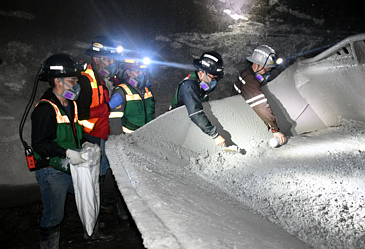 Wet muck inspectors at PTFI grab samples of a muck pile from a remote-operated loader. In the photo above the story, ore piled in draw points susceptible to wet muck is loaded from a safe distance by remote operators.Wet muck and the danger it poses to humans and equipment have been subjects of intense scrutiny, work and study for four decades at PT Freeport Indonesia, where one of the world’s largest underground mine complexes hums along in one of the world’s wettest and most seismically active places.
Wet muck inspectors at PTFI grab samples of a muck pile from a remote-operated loader. In the photo above the story, ore piled in draw points susceptible to wet muck is loaded from a safe distance by remote operators.Wet muck and the danger it poses to humans and equipment have been subjects of intense scrutiny, work and study for four decades at PT Freeport Indonesia, where one of the world’s largest underground mine complexes hums along in one of the world’s wettest and most seismically active places.
Modeling shows wet muck will outpace dry ore at PTFI in the coming years, and as the percentage of wet material increases, the number of mud rush events also will increase. The wet muck risk begins in the underground at the muck pile, and if sent as ore, this risk is spread further downstream to ore flow and the mill. Until the material is at the mill, there is a chance it will misbehave and therefore need to be managed from mine through the mill. To a lesser degree, PTFI also must manage wet material on its surface waste piles.
“PTFI will need to develop new ways to manage these mud-rush events,” said Surya Nugraha, Manager, Hydrology-PTFI.
PTFI has used four decades of institutional knowledge combined with a dogged pursuit of complementary technological advances that function as a world-class wet muck warning system. Though PTFI removed operators from harm’s way decades ago with the advancement of remotely operated underground loaders, wet muck still poses safety threats to maintenance and production work.
"Encountering wet muck is the result of fine material and enough water to become saturated; this increases as the cave matures but can also be present on the first bucket taken from a drawpoint" said Fari Putra, Superintendent-Underground Hydrology-PTFI. "As the mine matures, the caved rock gets exposed to more grinding within the cave and therefore becomes finer, making it more susceptible to becoming wet muck."
Stuck with it
Just like time, wet muck flies – in the figurative sense anyway.
“In a presentation we use, we show that a mud rush event is almost like an explosion, and the rock and water mix flows at a rate faster than the fastest human can run and with incredible destructive forces,” Nugraha said.
Waiting out wet muck is as futile an endeavor as outrunning it. The forces that generate wet muck from precipitation (Grasberg is one of the rainiest places in the world), to dynamics (Grasberg is one of the most seismically active places in the world), to cave conditions and the mining sequence are such that wet muck is not something you make go away, but rather something you manage. If ignored, it spreads and becomes even more of an issue.
“In 2022, we brought an analytical approach to the effort, using video data to mitigate mud-rush events prior to them happening,” said Tomy Indarto, Senior Manager, MIS Applications and Innovation-PTFI.
The data science model reads footage from smart cameras and measures the risks based on wetness and size of the materials, Indarto said.
A truly collaborative effort at PTFI with that technology brings in employees from Hydrology, Geoengineering, Health and Safety, Underground Engineering, Maintenance and Operations groups, wet muck inspectors, and even an ongoing wet muck committee. Nugraha said the improvements that have progressed the wet muck effort include:
- Continued collaboration between Operations, Maintenance, Engineering and the world-class Geoengineering Integrated Monitoring Center
- Improvements in the technology of the Minegem remote loaders run from the safety of a control room hundreds of feet above the mine
- Geology mapping with technology that uses cameras and instruments to categorize the rock
- Inspection mapping with tablets incorporated with GIS
- Wet muck classes for inspectors, engineers and managers
Physical inspections of rock and cave conditions are conducted at draw points. Inspectors collect and study samples by rock type, fragmentation and moisture. If conditions are unsafe, ore is mined at the draw point by a remote-operated loader and delivered down the drift to inspectors in a safe area.
Those physical inspections are enhanced with modeling and analysis, including software that can digitally calculate fragmentation from images and lab analysis to reveal moisture content and other properties.
“In our committee and subcommittee meetings, we are always bringing up potential ways to improve the predicting sphere and testing for the future,” Nugraha said. “We have fines forecasting (prediction of the amount of fine material in the ore), hydrological testing and simulation methods that can be very beneficial.”
